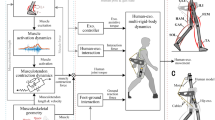Abstract.
In order to analyze the influence of gravity and body characteristics on the control of center of mass (CM) oscillations in stepping in place, equations of motion in oscillating systems were developed using a double-inverted pendulum model which accounts for both the head-arms-trunk (HAT) segment and the two-legged system. The principal goal of this work is to propose an equivalent model which makes use of the usual anthropometric data for the human body, in order to study the ability of postural control to adapt to the step frequency in this particular paradigm of human gait. This model allows the computation of CM-to-CP amplitude ratios, when the center of foot pressure (CP) oscillates, as a parametric function of the stepping in place frequency, whose parameters are gravity and major body characteristics. Motion analysis from a force plate was used to test the model by comparing experimental and simulated values of variations of the CM-to-CP amplitude ratio in the frontal plane versus the frequency. With data from the literature, the model is used to calculate the intersegmental torque which stabilizes the HAT when the Leg segment is subjected to a harmonic torque with an imposed frequency.
Similar content being viewed by others
Author information
Authors and Affiliations
Additional information
Received: 24 February 1997 / Accepted in revised form: 30 June 1998
Rights and permissions
About this article
Cite this article
Breniere, Y., Ribreau, C. A double-inverted pendulum model for studying the adaptability of postural control to frequency during human stepping in place. Biol Cybern 79, 337–345 (1998). https://doi.org/10.1007/s004220050483
Issue Date:
DOI: https://doi.org/10.1007/s004220050483




